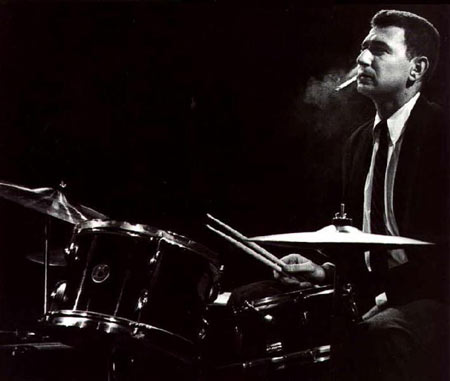
He would use the quintet opposite some of the headliners on weekends - imagine seeing visiting name artists and Shelly's band all in the same night. But the piano playing of Russ Freeman was about to depart from the long association with the club, the group, and Shelly.
He had watched the club grow from its inception. He could recall that when the room was expanded and the bandstand moved to the back wall that - “We could never get the acoustics and the 'feel' back there like it was when it was on the side. For years we tried all kinds of stuff - hanging things behind, a canopy over - just was never able to grab that sound.
The feel of the original bandstand was great. Every night was terrific playing there." He could also remember some of the players from the east putting Shelly's playing down. “They did not know what they were talking about, I guarantee you. They only heard the surface things - things that were different from the things they were used to hearing without realizing what it felt like to play with him. Playing with Shelly was a unique experience."
By the mid-sixties, jazz had changed so much that Freeman was losing interest. “It got so ridiculous that one time at the Manne-Hole a horn player would be at the front door of the club, another would be in the band room in the back, the drummer was on the stage and the piano player was hitting the keyboards with his fists. They were all playing at the same time, not listening to each other at all. People were sitting in the audience thinking this was just terrific. I thought wait a minute! This is too bizarre for me. I just didn't like the direction jazz was taking." Between that and the opportunity to make money in the show business end of music, Russ left the band. He took a job playing for Mitzi Gaynor's night club act that paid him ,'more money than I ever thought existed in the world." He worked with Gaynor for the next three years, then moved on to the Rowan & Martin's Laugh-In show.
The Men and the Airmen of Note recorded a live performance (with Shelly as guest artist) at the Pasadena Civic Auditorium, Howard Roberts used Shelly on an album for Capitol, and Nancy Wilson recorded with arrangements by Billy May and Oliver Nelson and drumming by Shelly Manne. The new Men - Candoli, Strozier, bassist Monty Budwig and pianist Mike Wofford, cut an album for Atlantic called Jazz Gunn [Atlantic LP/SD 1487].
Wofford was about to prove himself a most capable and sensitive keyboardist. Back from San Francisco, Monty replaced Chuck Berghofer, who had broken into the recording studio scene, making “These Boots Are Made For Walkin"' by Nancy Sinatra, among other hits.
In March, 1967, Shelly played the Academy Awards Show under the baton of Johnny Green and a week later was in the studios working on a commercial for Shell Oil. He did the album, How to Succeed in Business Without Really Trying for Universal Artists, and he and Ray Brown played on the Andre Previn-Leontyne Price album called Right As Rain. At the end of April, the new Men played the Jazz Workshop in San Francisco for five days. Early summer saw more session dates for the Men on the Atlantic and Concord labels. In August there was a Tommy Vig big band session and by September, the musical drummer began work on the story boards and cues for an animation feature called The Box.
Shelly was becoming very upset about critics trying to merge jazz with rock and other forms of current pop music. He told Leonard Feather - “Too many people are trying too hard to give the impression that there are no more boundary lines between jazz and pop, or between any one kind of music and another." He continued - If the public thinks pop and jazz are the same, creativity will be smothered." Manne was always trying to keep the art form creative. He booked acts in the Manne-Hole that didn't exactly fit his views of what jazz was, but he invited freedom within the art form. After all, he booked in Archie Schepp when he knew that the musician was known to karate-chop the piano as part of his repertoire.
Shelly booked Miles into the Manne-Hole and it was an absolute success. It was the most expensive group the club had ever booked and though Miles was infamous in his habit of fluffing off people and club owners, Shelly had nothing but great things to say about the famous jazz star. “A lot of people put Miles down, and he does have his faults, but at the Manne-Hole he really took care of business." There were people swarming all over the little club, the musician's room was always full of friends and fans, but he would always watch the time and played full sets. “One time, when the crowd outside was huge, he even split the last set and played an extra one." The problem the Manne- Hole management had was that, too often, they would call to re-book a group a year later, and the cost had gone out-of-sight.
For more information contact All About Jazz.




























